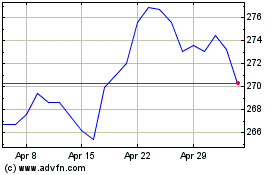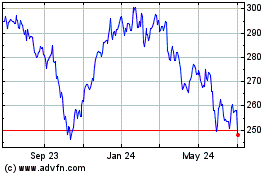By Heather Haddon and Jacob Bunge
The hottest item in the burger business is chicken.
At least 10 major U.S. fast-food chains have introduced
fried-chicken sandwiches in the past three months, or are set to
shortly. Many of those peddling the new poultry items are better
known as hamburger chains, including McDonald's Corp., Shake Shack
Inc. and Jack in the Box Inc.
Restaurant operators, grappling with slowdowns and restrictions
brought on by the Covid-19 pandemic, aim to capture consumers'
enthusiasm for crispy, breaded-chicken sandwiches. That fervor
helped build Chick-fil-A Inc. into one of the nation's top
fast-food chains over the past decade, and made Popeyes Louisiana
Kitchen Inc.'s offering a social-media sensation after its 2019
debut.
The chicken-sandwich war, as industry competitors describe it,
means diners have lots of options -- such as a Korean-style
iteration at Shake Shack, a McDonald's version topped with spicy
pepper sauce and a new KFC offering that the chain bills as its
"best chicken sandwich ever." The sandwich craze also might bring
lasting changes to the restaurant business, with owners spending
thousands of dollars on new equipment for battering chicken filets
to compete for what some franchisees say is the future of eating
out.
Shake Shack began selling its new fried-chicken sandwich in the
burger chain's South Korean restaurants during the fall, before it
made its debut in the U.S. this month. One of the first
limited-time items it put on menus during the pandemic was a spicy
chicken sandwich, also during the fall.
"We just want to sell more chicken," said Shake Shack Chief
Executive Randy Garutti in an interview. "People are always going
to love burgers and chicken, and we want to be known for both."
The largest restaurant and convenience chains promoted 213
chicken sandwiches through November last year, up 22% from a year
earlier, industry research firm Technomic Inc. said. Many of those
sandwiches have found a permanent place on menus.
Fast-food restaurants remain bastions of beef, with Big Macs,
Whoppers and other burgers outselling breaded-chicken sandwiches by
roughly 3-to-1, according to data from market-research firm NPD
Group.
Beyond fast food, though, chicken has been Americans' meat of
choice for decades.
Chicken overtook beef in 1992 as the most-consumed meat per
capita in America, according to the U.S. Department of Agriculture.
Consumers bought 1.4 billion more units of chicken than beef last
year in grocery stores, according to Nielsen figures.
The number of fast-food customers who ate a chicken sandwich
rose 21% last year from 2019, outpacing burgers, roast beef and
other similar items, according to Technomic surveys.
"It's hard not to succumb to temptation," said Mimi Finley, a
Tampa, Fla.-area stay-at-home mom and former restaurateur who likes
to sample chicken sandwiches from fast-food chains.
Chick-fil-A's signature chicken-breast sandwich, served with
pickles on a buttered, toasted bun, helped make the Georgia-based
company the third-biggest U.S. restaurant chain by domestic sales,
behind McDonald's and Starbucks Corp. Fanatical diners camp out
ahead of the chain's new restaurant openings, and Chick-fil-A
overtook KFC as the leading U.S. chicken chain by domestic sales in
2011, according to Technomic.
The 2019 launch of the Popeyes Chicken Sandwich spawned long
lines at restaurants and a temporary shortage that upset some
customers and sent the chain searching for supplies. The Restaurant
Brands International Inc.-owned chain's sales grew by double-digit
percentages, and have remained elevated since.
"Others have seen that success and are catching up," Sami
Siddiqui, president for the Americas at Popeyes, said in an
interview about the company's sandwich.
The new sandwiches are well-timed for fast-food chains and
chicken suppliers.
The jumbo-size boneless, skinless breast meat favored for such
products is typically the poultry industry's most profitable cut.
The average weekly price for a boneless, skinless chicken breast
last year was about $1.01 a pound, the lowest level in more than 30
years. The price had languished below $1 since August, until it
crept back above that level this month, according to data compiled
by market-research firm Urner Barry.
Sit-down-restaurant closures and export slowdowns have helped
build supplies. The quantity of frozen breast meat in U.S.
cold-storage facilities in late November stood 23% above last
year's level.
Some in the chicken industry said the sandwich launches could
send prices higher. Prices for jumbo boneless, skinless breasts
have topped $2 a pound only twice in the past decade, in 2013 and
in 2014, according to Urner Barry.
Both peaks, which came when meat prices already were riding
high, coincided with fast-food chicken skirmishes. McDonald's in
2013 launched chicken wraps, while Dunkin', Jack in the Box and
Wendy's Co. all promoted chicken sandwiches. A year later, Wendy's
and McDonald's both introduced new chicken sandwiches, while KFC
promoted its Double Down sandwich, in which bacon, cheese and sauce
were sandwiched between hunks of fried chicken.
Hailing the new chicken competition are poultry executives, who
face pandemic-constrained dining and surging grain prices. "We wish
all the participants much success," said Joe Sanderson, chief
executive of Sanderson Farms Inc., the third-largest U.S. poultry
producer, after Tyson Foods Inc. and Pilgrim's Pride Corp.
Chicken sandwiches tend to be more profitable than beef ones
sold in chain restaurants, as they draw on a cheaper commodity,
according to industry research firm Revenue Management Solutions.
Chicken sandwiches typically cost less on menus than big burgers, a
possible draw for budget-conscious consumers during the pandemic,
the firm said.
Restaurant chains and franchisees are investing heavily in the
battle. KFC said it worked with six bakeries to find a bun able to
handle its quarter-pound white-meat filet that will make its
nationwide debut in February, a chicken patty about 20% larger than
its existing crispy option. Church's Chicken owners spent about
$3,000 per restaurant to buy equipment to make the chain's new
chicken sandwich, while Burger King owners are buying battering
stations to install in kitchens as the Restaurant Brands chain
tests a hand-breaded chicken sandwich.
At McDonald's, which hasn't had a Southern-style
battered-chicken sandwich on its U.S. menus nationwide for years,
franchisees have been pushing for one.
"We cannot afford to be last in a category that clearly is the
future of fast food," the National Owners Association, a group of
McDonald's franchisees in the U.S., said in an email to members
last month.
Responding to customer demand, McDonald's said it would begin
selling a Crispy Chicken Sandwich next month with crinkle-cut
pickles on a buttered potato bun, while adding two other chicken
sandwiches to the permanent menu.
McDonald's executives told franchisees during an internal
meeting in December that a successful crispy-chicken-sandwich
launch was a priority. Executives said they were studying how to
introduce more chicken at breakfast, an option long sought by
franchisees in the South.
"Developing a reputation for great chicken represents one of our
highest aspirations," McDonald's U.S. President Joe Erlinger said
during an investor presentation last month.
Write to Heather Haddon at heather.haddon@wsj.com and Jacob
Bunge at jacob.bunge@wsj.com
(END) Dow Jones Newswires
January 19, 2021 05:44 ET (10:44 GMT)
Copyright (c) 2021 Dow Jones & Company, Inc.
McDonalds (NYSE:MCD)
Historical Stock Chart
From Mar 2024 to Apr 2024

McDonalds (NYSE:MCD)
Historical Stock Chart
From Apr 2023 to Apr 2024
